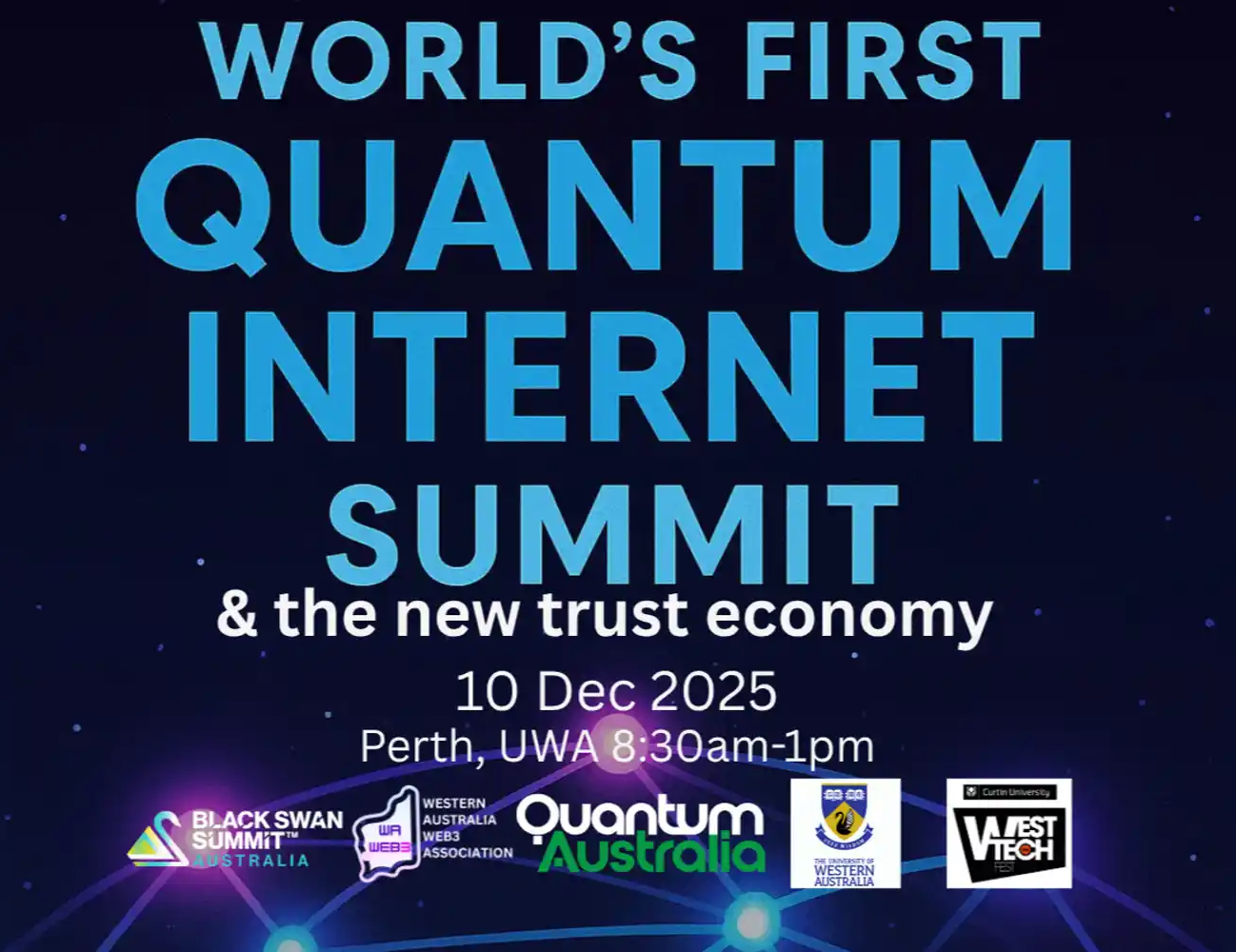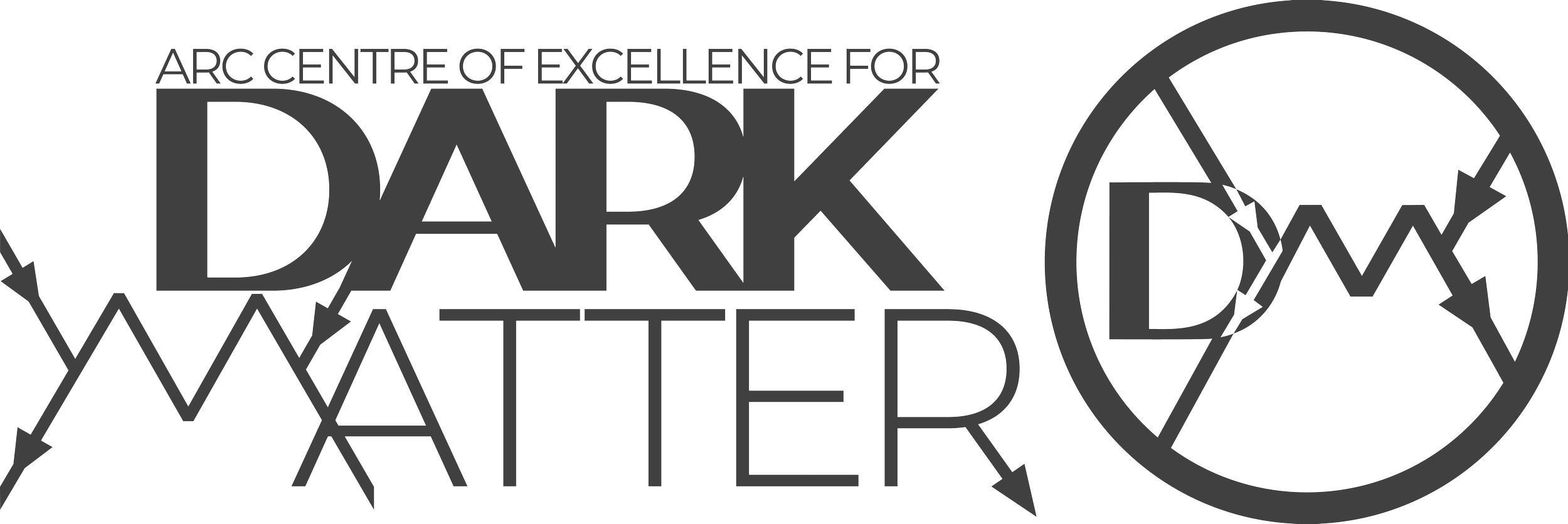
Quantum Internet Summit
World’s First Quantum Internet Summit
The Quantum Internet Summit – Perth 2025 organised by the Western Australia Web3 Association together with Quantum Australia and UWA as a satellite event of the West Tech Fest - marks the world’s first gathering dedicated to the next great leap in communication technologies and digital economy. Quantum Internet is a revolutionary step that could transform our world and ignite a new multi-trillion-dollar global economy built on trust, security, and sovereignty, as never experienced before. It promises ultra-secure communication, super-powered computation, and unprecedented sensing capabilities transforming all sectors.
You will learn what quantum internet is and why it is so exciting; have a quick intro to quantum tech in plain language; learn about the opportunities in the new quantum-digital diversified economy for individuals, investors, businesses, entrepreneurs ($funding opportunities), corporations and governments; connect with innovators, researchers, entrepreneurs and leaders in the field. Hear how quantum will change web3, blockchain and all other sectors. You will also hear about the exciting vision for Quantum R&D and innovation revolutionising and diversifying the Western Australian economy.
Wednesday, 10 December
8:30 am to 1pm AWST
Location: eZone, UWA
Register via this link: Quantum Internet Summit
In an age where AI can fake almost anything — from voices to “breaking news” — and trust online is collapsing, the Quantum Internet promises something revolutionary: a network of proof, where authenticity and identity are guaranteed by the laws of physics, not algorithms or corporations.
Entrepreneurs (including creatives) and researchers who explore quantum or quantum related projects will learn about exciting funding opportunities with Quantum Australia!

CDM Fortnightly Meeting—Robert Renz Marcelo Gregorio
Radon Mitigation and Detection for Dark Matter Experiments

Annual Workshop—Centre for Dark Matter Particle Physics
The fourth Centre Annual Workshop will be held on Wednesday 19th - Friday 21st November 2025. The workshop will be held at the the Rex Hotel, in Canberra, ACT.
The registration link has been emailed to members. Members can also register via the Polestar landing page.

ECR Workshop—Centre for Dark Matter Particle Physics
The ARC Centre for Dark Matter Particle Physics Annual Early Career Researcher (ECR) Workshop for 2026 will be held on Monday 17 November and Tuesday 18 November 2025 at the Rex Hotel, Canberra ACT.
See email invitation for registration link and program details.
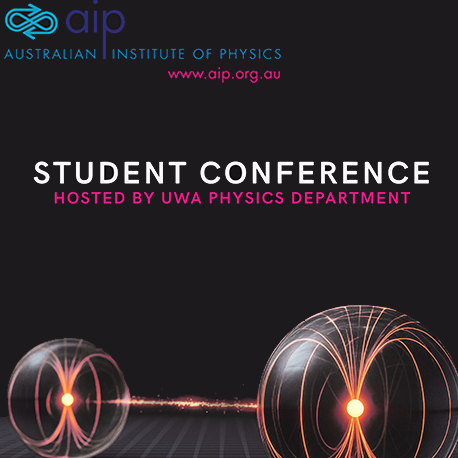
AIP—WA Student Conference for 2025
The AIP-WA branch is holding it's annual Student conference for 2025, scheduled on 14th November at "Ross Lecture Theatre", The University of Western Australia, where students doing their Honours/ Masters /PhD from different stream of Physics, including Applied Physics, Experimental, Astrophysics, Computational, Medical and Geophysics will be presenting their research work in a full day event.
There, you not only get a chance to showcase their work, but you would also interact with different industry partners and research fellow students from different Universities across Western Australia, including Curtin and Murdoch. You also get a chance to discuss research topics with the experts in their field and have a showcase with the industry partners.
This event is a fully catered event with Food and Drinks being served for the entire day. Best Student presentations, poster and 3MT will be awarded. The event is open for registration. Please register yourself to present your work for the event using the QR code provided in the registration link.
Please find out other details in the below link about the event :

CDM Fortnightly Meeting—Robert Mostoghiu Paun
Join the CDM Fortnighly Meeting on 6 November 2025 at 10am AWST (to be confirmed).
Robert Mostoghiu Paun of Swinburne University will give a talk on:
Primordial Black Hole Project
Join with the zoom link in your calendar invitation.
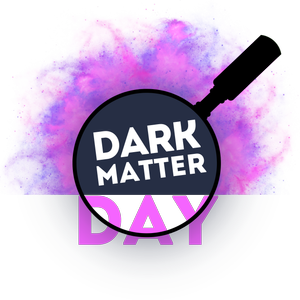
Dark Matter Day 2026
To celebrate Dark Matter Day, The ARC Centre for Dark Matter Particle Physics is excited to be travelling around the world, with live links to two fascinating underground labs that are part of the search for the elusive dark matter: the Stawell Underground Physics Laboratory and the Boulby Underground Laboratory.
Our underground labs are - among other things! - part of the international hunt for dark matter, the missing mass of the Universe. Join us online for this more in-depth look at what dark matter is and why we think it's real, despite not yet being able to detect it directly! This event is suitable for ages 12+.
Stawell Underground Physics Laboratory (SUPL) is located 1,025 metres below the surface within an operational gold mine west of Melbourne, SUPL is the only deep underground laboratory in the Southern Hemisphere. Built primarily to host the SABRE South dark matter experiment, SUPL has been operational for two years and provides an ultra-quiet environment for world-leading research into the mysteries of the universe.
Boulby Underground Laboratory is the UK’s deep underground science facility, 1.1 km underground in Britain’s deepest mine. Boulby Underground Lab hosts a wide array of both pure and applied multidisciplinary science - from low-background particle physics and the hunt for dark matter, to testing of Mars rover technologies and renewable energy storage studies.
This event will start at 10:00 GMT (21:00 AEDT) and will run until approximately 11:00 (22:00 AEDT). There will be plenty of opportunity to ask questions.
One ticket is required for each device that will be used to watch the event.

Hunting axions with the James Webb Space Telescope
Please join the University of Melbourne, Theoretical Particle Physics Seminar Series for our final seminar of the year, at 11am(AEDT), 8am(AWST) on Wednesday the 29nd of October, given by Elena Pinetti (Flatiron Institute):
Hunting axions with the James Webb Space Telescope
Axions with a mass around 1 eV can decay into near-infrared photons. Utilizing blank-sky observations from the James Webb Space Telescope, I search for a narrow emission line due to decaying dark matter and derive leading constraints on the axion-photon coupling in the eV-scale mass range.
**Note: we have a new Zoom Link**
Zoom link: https://unimelb.zoom.us/j/81747510182?pwd=aXQo7iab5f73uaDnhWNdV5YGrmrmy6.1
Password: tppseminar

CDM Fortnightly Meeting—Ciaran O’Hare
The next CDM Fortnightly meeting is on Thursday 23rd October at 1:00PM AEDT/10AM AWST
This week Ciaran O’Hare will be giving a presentation titled: Fine-grained dark matter substructure and axion haloscopes
There will be opportunity after the presentation for further announcements and/or updates.
Check your calendar reminders for the zoom link.

Physics Seminar—Emmanuel Flurin
Join us for a Physics Seminar this Friday at 9am
Venue: room 2.15, Physics
The presenter is Dr Emmanuel Flurin of Quantronics Group, France who is currently in Australia visiting the QDM Lab and
Title: Counting Microwave Photons with Qubits: From Spin Spectroscopy to Axion Dark Matter Search
Abstract:
Detecting single microwave photons is challenging because their energies are over five orders of magnitude lower than those of optical photons, making conventional photoionization schemes ineffective. Quantum technologies—particularly superconducting circuits—can overcome this challenge by encoding microwave photon arrivals into the state of a superconducting quantum bit, which can then be read out with high fidelity. In this talk, I will first introduce the SMPD architecture: a transmon qubit driven in a cyclic four-wave mixing process that maps itinerant photons onto its excited state with near-unity efficiency [1]. I will then describe the integration of the SMPD into various applications in the microwave domain. First, I will discuss particle physics, specifically the search for hypothetical axion particles using haloscopes—frequency-tunable, high-quality-factor three-dimensional cavities placed in strong magnetic fields designed to induce the decay of galactic axions into microwave photons. Here, SMPD-based detection schemes have enabled a twentyfold increase in search speed around 7 GHz compared to quantum-limited linear amplifiers [3]. Next, I will cover applications in single-spin magnetic resonance: detecting individual erbium ions coupled to a millikelvin planar superconducting resonator [2], and performing nuclear magnetic resonance on tungsten nuclear spins adjacent to erbium ions in a host crystal, achieving quantum-non-demolition readout and demonstrating second-scale coherence times [4]. Finally, I will show that SMPD sensitivity can be significantly enhanced by employing multiple qubits and elementary error-correction methods [5],` suggesting that, much like optical single-photon detection has driven advances across numerous fields, highly sensitive SMPDs could similarly catalyze new scientific discoveries and applications in the microwave domain.
References:
[1] R. Lescanne et al., Phys. Rev. X 10(2), 2020.
[2] Z. Wang et al., Nature, 2023.
[3] C. Braggio et al., Phys. Rev. X, 2025.
[4] J. O’Sullivan et al., arXiv:2410.10432, 2024.
[5] A. S. May et al., arXiv:2502.14804, 2025.

CDM Fortnightly Meeting
Please join us at the next CDM Fortnightly meeting this Thursday the 9th of October at 10am AWST.
Robert Crew will be giving a presentation titled "Low AM-Noise Detection for the Twisted Anyon Cavity ULDM Search”.
There will be opportunity after the presentation for further announcements and/or updates.
For the zoom link, check your CDM fortnightly meetings calendar invitation or request the link from Linda.

The dark matter problem as a topsy-turvy version of the strong CP problem
Associate Professor Tom Melia, IPMU (Kavli Institute for Physics and Mathematics of the Universe) University of Tokyo
The vacuum states of QCD generically break CP symmetry, and are parameterised by the ‘QCD theta’ variable. The strong CP problem arises because experiment shows that the amount of QCD CP violation must be exceedingly small, at odds with our generic expectation. This problem has a dynamical solution – the QCD axion – which zeroes any observable effects of CP violation through a relaxation mechanism.
The vacuum states of electromagnetism and gravity generically break Lorentz symmetry, and are parameterised by a ‘shadow’ charge and matter density. Similar to the case of theta-vacua, we should expect that we live in a generic state of these gauge theories, and would thus observe ‘shadow’ fluids in the universe. Because these fluids can behave like cold dark matter, we could view dark matter’s existence as a confirmation of our expectations about the vacuum of EM and GR. On the other hand, there is a well-known relaxation mechanism – inflation – that, if realised in our universe, would dynamically ruin this solution to the DM problem by diluting the shadow fluids away. Thus one is led to a topsy-turvy version of the strong CP problem – one has to address how not to dynamically relax a generic vacuum state.
Along the way, I will point out that the Hamiltonian formalism makes clear that 1) symmetry-based approaches to the strong CP problem do not solve it, and 2) choosing generic vacuum states in GR (that do not satisfy the Wheeler-DeWitt equation) offers an extremely simple solution to the ‘problem of time evolution’.

Public Talk: Will Campbell "Yes, We're Still Looking"
Find Out How Exactly We Plan to Search for Dark Matter Using Quantum Physics
Date: Wednesday 13th August 2025
Time: 6:30–8.00 pm
Venue: Ross Lecture Theatre, The University of Western Australia, WA
Register here: Perth Public Talk: Yes, We're Still Looking! - Find Out How Exactly We Plan to Search for Dark Matter Using Quantum Physics
From dark matter to gravitational waves, some of the most fascinating mysteries in physics lie far beyond the reach of conventional tools. But recent advances in quantum technology, especially in quantum sensing, are opening new windows into these hidden realms.
In this talk, I’ll explore how we use quantum technologies to detect subtle, elusive signals from the universe, and why we’re looking in the first place. Together, we’ll walk through the working principles of advanced devices that harness quantum effects to make ultra-sensitive measurements, enabling researchers around the world to search for gravitational waves, dark matter, and other signatures of new physics.
Along the way, I’ll explain what makes a technology “quantum,” why it matters, and how Australia, including researchers right here in Western Australia, is playing a leading role in this global effort. Whether you’re a curious high school student or an experienced professional, there will be something of interest in discovering the world-class research happening right here in your own backyard.
About Dr William Campbell:
A research associate in experimental physics at the University of Western Australia. Having completed an honours in physics as well as his PhD with the Quantum Technologies and Dark Matter Research Labs at UWA, he specialises in the study and application of hybrid quantum acoustic systems for fundamental physics. As well as pure scientific research Will’s interests also lie in the education of quantum physics in schools and increasing the general take-up of STEM-based careers.

CDM Fortnightly Meeting
Today’s presentation ‘The Belle II Experiment’ is given by Eiasha Waheed. Please join us at 11am Perth time.
Dr Eiasha Waheed is a postdoctoral researcher at the University of Melbourne working on Axion-like particle (ALP) measurements at the Belle II experiment. ALPs could provide a portal connecting SM particles to Dark Matter.
There will be opportunity after the presentation for further announcements and/or updates.
Refer to your calendar invite for the zoom link.

CDM Fortnightly Meeting
Join us for the fortnightly CDM meeting.
This week’s speaker is Alasdair McLean.
Title: A Scalable High Gain Negative Ion Drift CYGNUS Prototype for Directional Dark Matter Detection.
There will be opportunity after the presentation for further announcements and/or updates.
Check your calendar for the zoom link for the fortnightly CDM meetings. To request a calendar invitation, see Linda.

CDM Fortnightly Meetings
Please join us at the next CDM Fortnightly meeting on Thursday the 19th of June at 1:00PM AWST.
This week Antoine Cools, will be giving a presentation - Optical Readout Gaseous Detectors: Industrial Applications and Beyond
There will be opportunity after the presentation for further announcements and/or updates.
Please refer to your calendar event for the fortnightly zoom meetings link.
About this week’s presenter:
Antoine Cools is a postdoctoral fellow at the University of Melbourne involved in the SABRE experiment and working on medical imaging. During his PhD at Saclay University, France, he developed new optically read out gaseous detectors for rare event detection, X-ray and neutron radiography, as well as medical imaging.

CDM Fortnightly Meeting
Please join us at the next CDM Fortnightly meeting this Thursday the 5th of June at 11am AWST.
This week Dr Leonie Einfalt, one of our newest Research Fellows at the Centre working on the SABRE experiment, will be giving a presentation titled "Giving DAMA the Cold Shoulder: NaI at Millikelvin Temperatures in the COSINUS Experiment” 💫
There will be opportunity after the presentation for further announcements and/or updates.
Please refer to your calendar event for the CDM Fortnightly Meetings for the Zoom link.
About this week’s presenter:
Leonie Einfalt is a postdoctoral fellow at the University of Melbourne working on the SABRE experiment. In her PhD she worked on high level data analysis and statistical inference for the cryogenic, scintillator-based dark matter searches COSINUS and CRESST.

Sydney CPPC Seminar: Dr Joshua Benabou (UC Berkeley)
Join CDM colleagues this Thursday 29th May at 9:00 am Perth Time for our next Sydney CPPC seminar.
See Ciaran O’Hare email 26/5/25 for the zoom link
What is the QCD axion mass?
The QCD axion may solve the strong CP problem and constitute the dark matter (DM) abundance in our Universe. Peccei-Quinn (PQ) axions may form axion strings if the PQ phase transition occurs after inflation. I will discuss recent advances in the computation of the QCD axion DM mass in this scenario from the most precise and accurate lattice simulations to-date of axion-string networks, leading to a predicted mass range of 40 - 300 µeV. On the other hand, string theory axions, which are compelling solutions to the PQ quality problem, do not generically form strings - except in special inflationary paradigms such as brane inflation - meaning that there is no unique predicted value for the QCD axion DM mass. Nonetheless, if a Grand Unified Theory is assumed, I will explain why in broad regions of the string landscape, the mass of a stringy QCD axion is expected to be ~ 0.01 to 10 neV, independently of its DM fraction.

CDM Seminar: Dr Johannes Herms (IPMU)
Please join CDM next Wednesday, May 28th, at 9 am (Perth time) for an in-person seminar by Johannes Herms (IPMU).
See Stephan Meighen-Berger email (22/5/25) for zoom link
--------------------------------------------------------------------------------------------------
Abstract:
Sub-GeV thermal relics through the light scalar doublet portal
Thermal relic particles are a prime dark matter candidate. They have traditionally been searched for around the electroweak scale, but can be viable down to masses of a few MeV. This talk outlines the two challenges faced by the sub-GeV thermal relic scenario, and how overcoming them shapes the study of sub-GeV thermal relic models.
Models of light thermal relic dark matter can be characterized by the new light mediator that they typically require to enable sufficient dark matter depletion in the early Universe. I present the possibility of a light mediator originating from a second Higgs doublet, and explore its consequences for DM production, neutrino masses, DM indirect detection as well as the LHC.
Honours and Masters Proposals—Physics
Please come and support our Honours and Masters students delivering their research proposals on Thursday.
Especially Charlie and Evangelos!
Honours and Master's Proposal Presentation (Experimental specialisation)
Time: Thursday 15th of May
Venue: PHYSICS 2.15 See Teams invitation for online meeting ID
All welcome
2:00–2:15pm Charlie Campbell Honours Detecting dark matter with superfluid helium
2:15–2:30pm Evangelos Hajigabriel Honours Synthetic Resonance for Fundamental Physics Detection Experiments
2:30–2:35pm Ash Hamer Honours Investigating the Noise floor of the Fluid Suspension Rotation Isolator
2:35–2:55pm Liam Dovey Masters Atom Interferometric Methods in a Neutral Ytterbium Optical Clock
2:55–3:15pm Emily Mazalevskis Masters The Optomechanical Interactions of the Lollipop Resonator
3:15–3:35pm Rem Madlener Masters Low Frequency Rotational Sensors

Professor Gerard Milburn Public Lecture—in-person and online
Come listen to Gerard Milburn talk about how quantum computing is changing the game in real-world applications!
On behalf of the ARC Centre of Excellence for Engineered Quantum Systems (EQUS), Quantum Australia, the Queensland Government, and the Australian Institute of Physics, Queensland branch (AIP), we are pleased to invite you to a public lecture by Gerard Milburn, a pioneer in quantum technologies, on the real-world applications of quantum computing. This event will take place on the evening of 13 May at Brisbane City Hall, Brisbane Room, to celebrate the International Year of Quantum Science and Technology. The lecture will also be live streamed.
This lecture will explore how quantum computing is being applied to tackle complex, real-world challenges across industries. Whether you are an expert in the field or simply interested in its potential, this event promises valuable insights into the future of quantum technologies.
On-line attendance - register here to obtain the link.
If attending in person, arrival is 5:45pm for a 6:00pm start. Following the talk, there will be light refreshments where attendees can engage directly with Professor Milburn and other leading academics in the quantum physics industry.
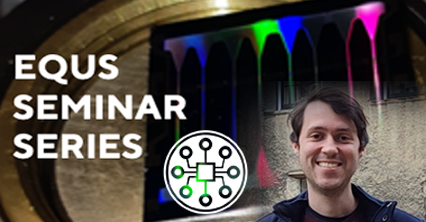
EQUS Seminar Series 2025
Germain Tobar: Detecting single gravitons with quantum-controlled mechanical resonators
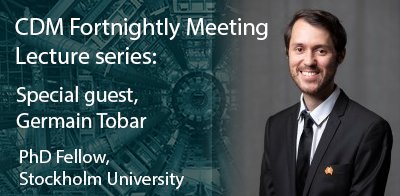
CDM Fortnightly Meeting
Special guest, PhD Fellow Germain Tobar from Stockholm University will be giving a presentation titled "Detecting single gravitons with quantum controlled mechanical oscillators". 💫
Abstract: The quantization of gravity is widely believed to result in gravitons - particles of discrete energy that form gravitational waves. But their detection has so far been considered impossible. Here we show that signatures of single gravitons can be observed in laboratory experiments. We show that stimulated and spontaneous single graviton processes can become relevant for massive quantum acoustic resonators and that stimulated absorption can be resolved through optomechanical read-out of single phonons of a multi-mode bar resonator. We analyse the feasibility of observing a signal from the inspiral, merger and post-merger phase of a compact binary inspiral. Our results show that single graviton signatures are within reach of experiments. In analogy to the discovery of the photoelectric effect for photons, such signatures can provide the first experimental evidence of the quantization of gravity. https://www.nature.com/articles/s41467-024-51420-8
Bio: Germain Tobar completed his honours working on closed time-like curves at the University of Queensland. He then did a masters in theoretical physics under a Cambridge Australia Allen Scholarship before undertaking a PhD at the Stockholm University. Yes, they are related.
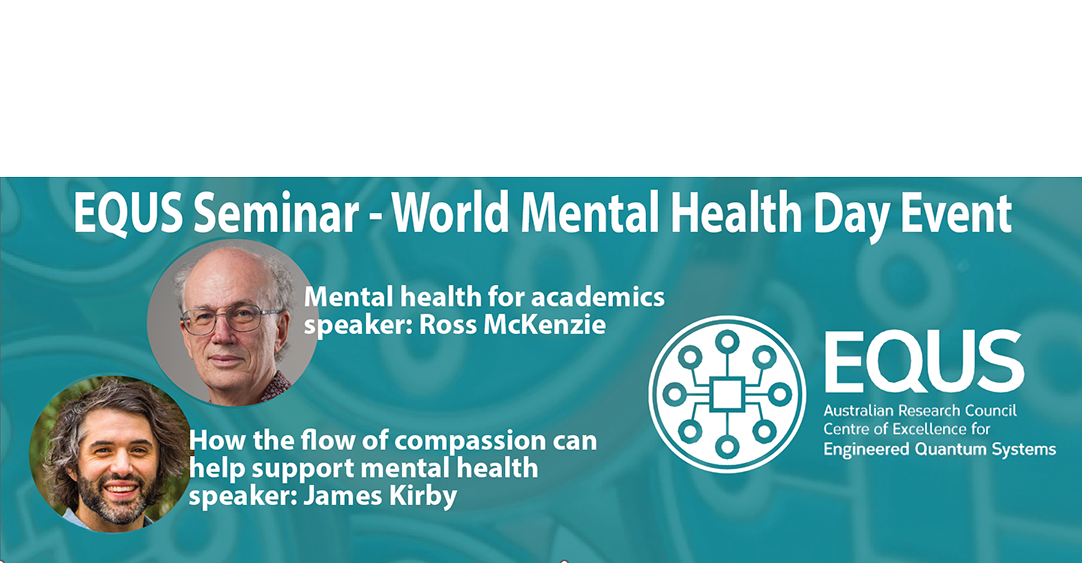
EQUS Seminar - World Mental Health Day Event
Venue: B22 QDM Lab Meeting Room. Morning tea will be served.
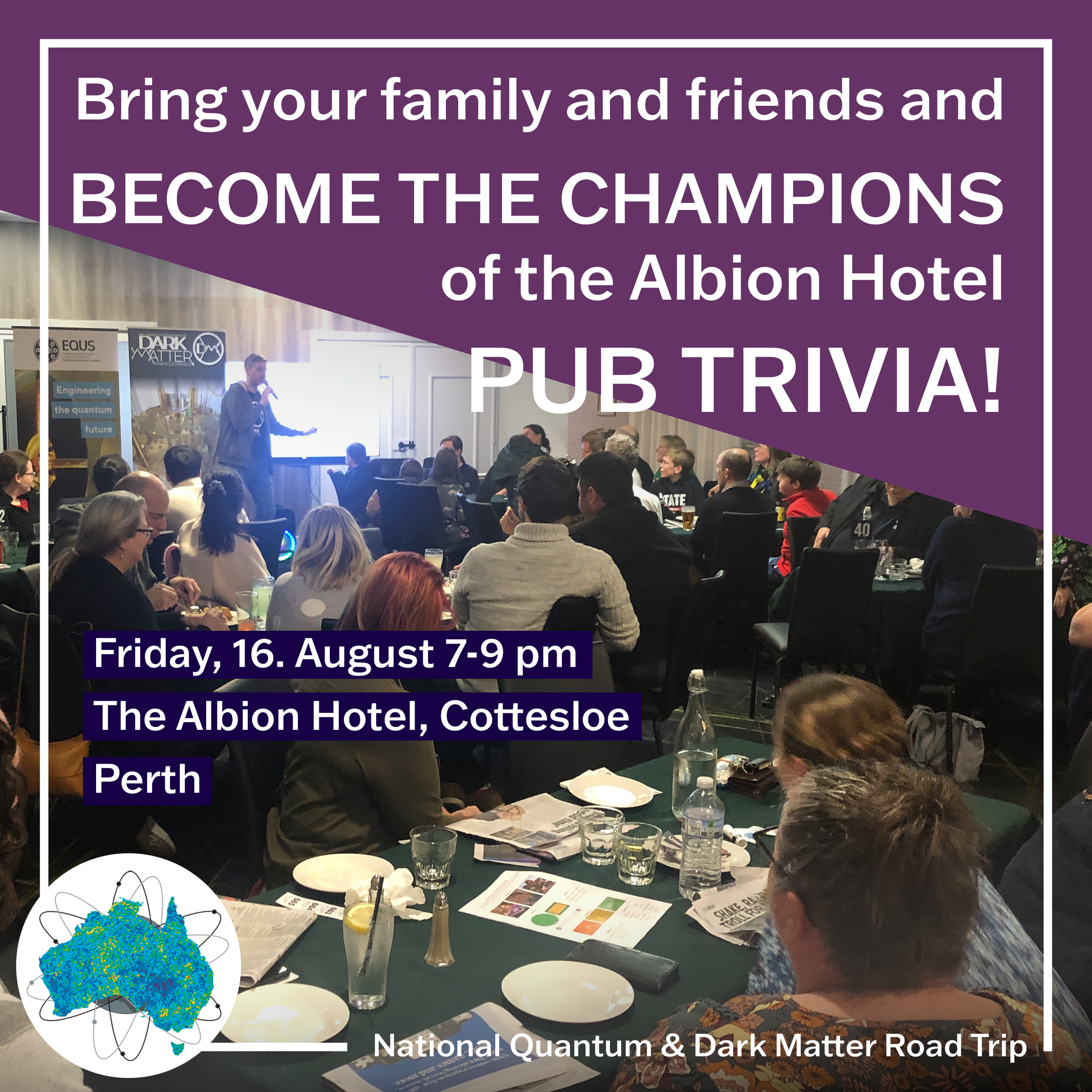
Pub Trivia Night - Albion Hotel, Cottesloe
Join the National Quantum & Dark Matter Road Trip in Perth for an evening of pub trivia, with a twist of science!
Will you be the champions of the Albion Hotel Pub Trivia? Gather your friends and family, get a team together, and come along to The Albion Hotel for a bit of trivia, with a twist of science.
Date: Friday 16 August 2023
Time: 7:00–9:00 pm
Venue: Queen Victoria room, upstairs at The Albion Hotel, 535 Stirling Highway, Cottesloe WA 6011
Don’t stress, our pub trivia won’t bring back nightmares of science exams past! Hosted by road-tripper Will, expect regular pub trivia, but with a science-y vibe, including topics like sport, movies, music, geography, pop culture and general knowledge, and a bonus ‘tomorrow’s science headlines’ activity.
FREE entry, with optional donation to DeadlyScience
Max. team size: 6 people (if you have more people, why not split into two teams and battle it out!)
Win prizes, but more importantly the sweet, sweet feeling of victory!
Please note: There is no lift to the Queen Victoria room, so unfortunately this event is not wheelchair-accessible.
Many thanks to The Albion Hotel for hosting us!
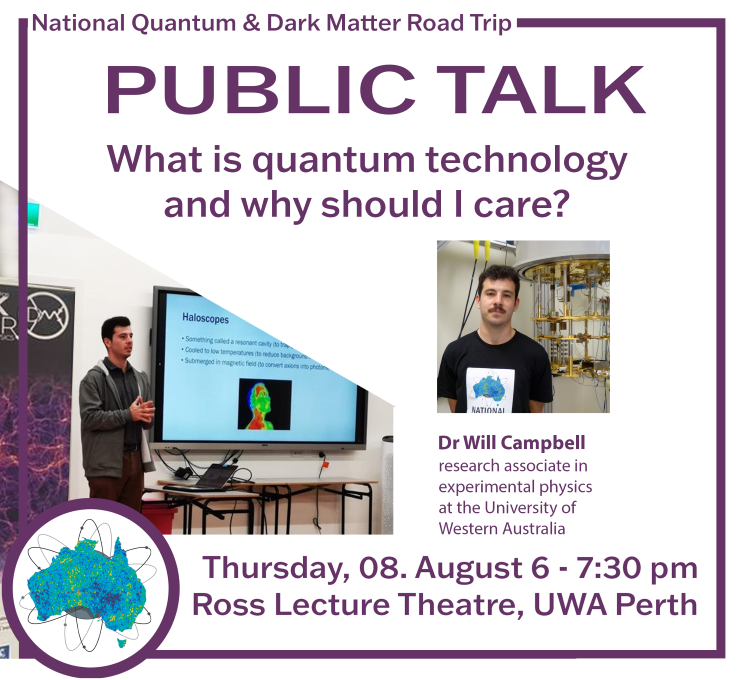
What is quantum technology and why should I care? The weird and wacky physics of single particles, and how it will help us build tomorrow’s technology
The National Quantum and Dark Matter Road Trip Public Lecture
Speaker: Dr Will Campbell
6pm - 7.30pm
Thursday 8 August 2024
Ross Lecture Theatre, Physics Building, UWA
Register to attend : Public talk (Perth): What is quantum technology and why should I care? | Humanitix
What does it mean for something to be quantum? Quantum computing, quantum communication and quantum sensing are all great examples of future technologies that harness the power of quantum mechanics. But what makes these new and exciting capabilities “quantum” exactly? How will they benefit me? What are the challenges in developing these systems? I’ll attempt to answer questions, such as these, you might have about the future of quantum technology. I’ll talk about the current and future directions of Australia’s world-leading involvement in quantum research and how quantum technologies are being used to search for exciting new physics such as dark matter and tiny black-hole collisions, all right here in Western Australia.
Speaker: Will Campbell
Dr William Campbell is a research associate in experimental physics at the University of Western Australia. Having completed an honours in physics as well as his PhD with the Quantum Technologies and Dark Matter Research Labs at UWA, he specialises in the study and application of hybrid quantum acoustic systems for fundamental physics. As well as pure scientific research Will’s interests also lie in the education of quantum physics in schools and increasing the general take-up of STEM-based careers.
We are very grateful to The University of Western Australia for their support of this event.
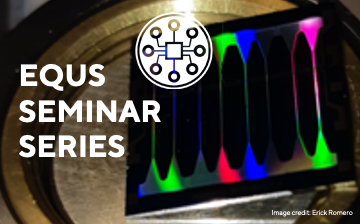
EQUS Seminar Series—International Women's Day
International Women’s Day: Navigating Research as a Woman in Quantum
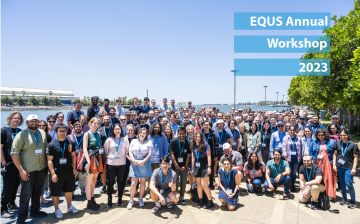
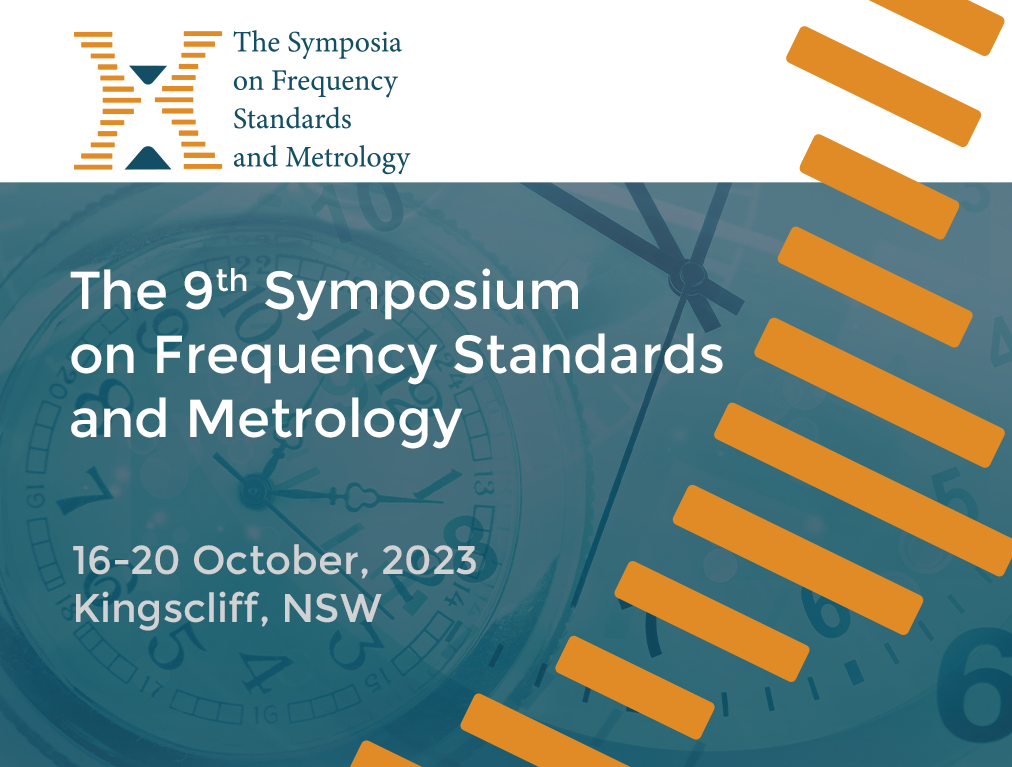
The 9th Symposium on Frequency Standards and Metrology
The 9th Symposium on Frequency Standards and Metrology will be held at the Mantra on Salt Beach Resort, Kingscliff, NSW, Australia, 16-20 October 2023. The symposium is intended to serve as an international discussion forum on precision frequency standards throughout the electromagnetic spectrum, and associated precision and quantum metrology. It focuses on the fundamental scientific aspects of the latest ideas, results, and applications in relation to these frequency standards and measurement techniques. More than Seven years after the last symposium very significant progress has occurred in various associated fields.
For full information please click here
